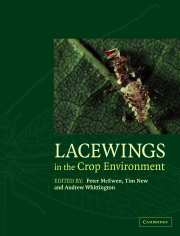Book contents
- Frontmatter
- Contents
- List of contributors
- Preface
- PART 1 Lacewing systematics and ecology
- PART 2 Lacewings in crops
- PART 3 Principles
- Introduction to Part 3
- CHAPTER 11 The use of lacewings in biological control
- CHAPTER 12 Mass-rearing, release techniques, and augmentation
- CHAPTER 13 Features of the nutrition of Chrysopidae larvae and larval artificial diets
- CHAPTER 14 Ecological studies of released lacewings in crops
- CHAPTER 15 Sampling and studying lacewings in crops
- CHAPTER 16 Interactions with plant management strategies
- CHAPTER 17 Lacewings, biological control, and conservation
- PART 4 Case studies
- PART 5 Conclusion
- Taxonomic index
- General index
CHAPTER 17 - Lacewings, biological control, and conservation
Published online by Cambridge University Press: 04 May 2010
- Frontmatter
- Contents
- List of contributors
- Preface
- PART 1 Lacewing systematics and ecology
- PART 2 Lacewings in crops
- PART 3 Principles
- Introduction to Part 3
- CHAPTER 11 The use of lacewings in biological control
- CHAPTER 12 Mass-rearing, release techniques, and augmentation
- CHAPTER 13 Features of the nutrition of Chrysopidae larvae and larval artificial diets
- CHAPTER 14 Ecological studies of released lacewings in crops
- CHAPTER 15 Sampling and studying lacewings in crops
- CHAPTER 16 Interactions with plant management strategies
- CHAPTER 17 Lacewings, biological control, and conservation
- PART 4 Case studies
- PART 5 Conclusion
- Taxonomic index
- General index
Summary
INTRODUCTION
Release of non-specific predatory insects into a new area implies responsibilities associated with a ‘duty of care’ for the receiving environment and, from the conservationist's viewpoint, is not always an exercise to be undertaken lightly, despite the seeming urgency of biological control measures against pest arthropods. The twin contexts that are relevant to introductions of lacewings are (1) release of species which are exotic to the areas where they are released (that is, as classical biological control agents, species not present previously in the region of introduction, for which the above precautions may be particularly important) and (2) native species whose populations are enhanced by releases from commercial stocks, or by use of attractants to concentrate field populations in more limited areas. Both approaches are usually part of IPM programmes undertaken with the overall aim of seeking more cost-efficient pest control with the economic and environmental benefits of reduced pesticide use.
Incorporation of predators into such strategies is increasingly undertaken with the aims of short-term gain and longer-term environmental safety. Nevertheless, it is pertinent here to recapitulate some of the responsibilities and concerns that such operations raise, and to emphasise the need to monitor introductions effectively to help improve further the application technologies and quality of the results obtained.
Many such releases are indeed undertaken with due regard to ‘acceptable risk’, but clear definition of those risks is itself a complex matter. Increasingly, such risks are being dealt with by a combination of regulations, protocols, and guidelines involving some degree of consensus of scientific and regulatory participants.
- Type
- Chapter
- Information
- Lacewings in the Crop Environment , pp. 380 - 384Publisher: Cambridge University PressPrint publication year: 2001



